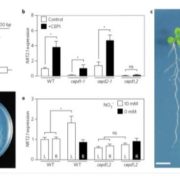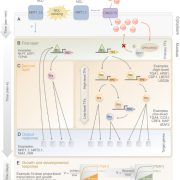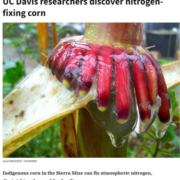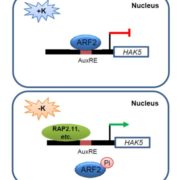Review. Milestones in understanding phosphorus uptake, transport, sensing, use, and signaling
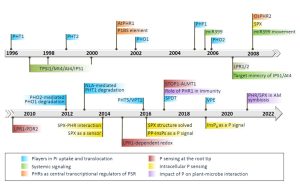 Phosphorus (P) is an essential nutrient and critical component of nucleic acids, phospholipids, and other molecules. Yang et al. provide a historical (since 1996) overview of the processes controlling its uptake and use. Plants take up P from the rhizosphere primarily in the form of orthophosphate (Pi). However, Pi in the soil often complexes with metal ions, limiting its availability. The discovery in 1996 of root-specific PHT1 phosphate transporters, localized in the plasma membrane and induced during Pi deficiency, initiated extensive exploration into this vital nutrient element. Subsequent identification of Pi transporters with expression in various tissues (e.g. stele, reproductive tissue, embryo) or subcellular organelles (e.g. chloroplasts/plastids, mitochondria, Golgi apparatus, vacuole) highlighted their role in mediating Pi uptake, cell-to-cell movement, and long-distance transport, thereby ensuring a balance between internal homeostasis and external supply and ultimately maximizing plant performance. Achieving this homeostasis demands a complex interplay of diverse and sophisticated molecular regulatory mechanisms including microRNAs, transcription factors, untranslated open reading frames, the ubiquitin ligase system, protein phosphorylation, and ligand-regulated protein-protein interactions. Furthermore, recent breakthroughs elucidating the structural-functional relationship of the regulatory PP-InsP/SPX/PHR complex not only enhance our understanding of the P signaling cascade but also unveil exciting opportunities for the interplay between P signaling and other crucial physiological processes, including nitrogen and iron homeostasis, and the dynamics of plant-microbe interactions. (Summary by Ching Chan @ntnuchanlab) Plant Cell 10.1093/plcell/koad326
Phosphorus (P) is an essential nutrient and critical component of nucleic acids, phospholipids, and other molecules. Yang et al. provide a historical (since 1996) overview of the processes controlling its uptake and use. Plants take up P from the rhizosphere primarily in the form of orthophosphate (Pi). However, Pi in the soil often complexes with metal ions, limiting its availability. The discovery in 1996 of root-specific PHT1 phosphate transporters, localized in the plasma membrane and induced during Pi deficiency, initiated extensive exploration into this vital nutrient element. Subsequent identification of Pi transporters with expression in various tissues (e.g. stele, reproductive tissue, embryo) or subcellular organelles (e.g. chloroplasts/plastids, mitochondria, Golgi apparatus, vacuole) highlighted their role in mediating Pi uptake, cell-to-cell movement, and long-distance transport, thereby ensuring a balance between internal homeostasis and external supply and ultimately maximizing plant performance. Achieving this homeostasis demands a complex interplay of diverse and sophisticated molecular regulatory mechanisms including microRNAs, transcription factors, untranslated open reading frames, the ubiquitin ligase system, protein phosphorylation, and ligand-regulated protein-protein interactions. Furthermore, recent breakthroughs elucidating the structural-functional relationship of the regulatory PP-InsP/SPX/PHR complex not only enhance our understanding of the P signaling cascade but also unveil exciting opportunities for the interplay between P signaling and other crucial physiological processes, including nitrogen and iron homeostasis, and the dynamics of plant-microbe interactions. (Summary by Ching Chan @ntnuchanlab) Plant Cell 10.1093/plcell/koad326



